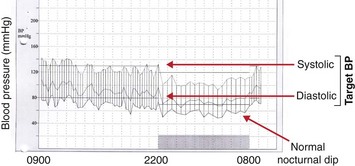68 Hypertension is a common clinical problem. It is defined as chronically increased systemic arterial blood pressure. The definition of hypertension has changed over the years, as more effective treatments have become available. The WHO classification of hypertension is shown in Table 68.1. It is important not to base clinical decisions on a single blood pressure reading. Some patients have ‘white coat’ hypertension, where readings taken by doctors or other health professionals are misleadingly high. Ambulatory blood pressure measurement over a whole day provides the most detailed information (Fig 68.1). Table 68.1 WHO classification of hypertension If hypertension is left untreated, patients are at risk of several complications. These include:
Hypertension
Category
BP (mmHg)
Optimal blood pressure
<120/80
Normal blood pressure
<130/85
Mild hypertension
140/90–159/99
Moderate hypertension
160/100–179/109
Severe hypertension
≥180/110
Hypertension









